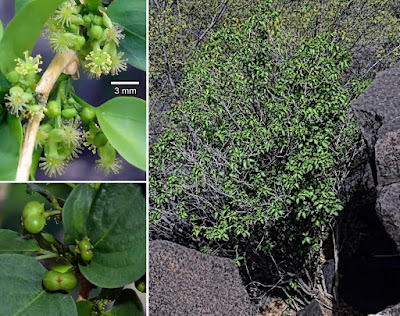 |
| Erythrococca kaokoensis Swanepoel |
Abstract
Erythrococca kaokoensis, here described as a new species, is only known from the mountains along the Kunene River in the Kaokoveld Centre of Endemism, southwestern Angola and northwestern Namibia. These shrubs or small trees grow among rocks of anorthosite, gneiss or limestone. Diagnostic characters for E. kaokoensis include the leaves that are subcordate or lanceolate to ovate, rarely elliptic, drying dark green, yellow-green, blue-green or violet to black, and the interruptedly racemose or subpaniculate inflorescences with flowers in clusters along the axis. A comparison of some of the more prominent morphological features to differentiate between E. kaokoensis and its possible nearest relative, E. trichogyne, is provided.
Keywords: endemism, flora, taxonomy, Zebra Mountains, Eudicots
Erythrococca kaokoensis Swanepoel, sp. nov.
Diagnosis:— A woody shrub to small tree 1.5–2.5 m tall, related to E. trichogyne, from which it differs in having the leaf lamina subcordate, lanceolate to ovate or rarely elliptic (vs. ovate, ovate-lanceolate, elliptic-lanceolate or elliptic to elliptic-ovate), drying dark green, yellow-green, blue-green or violet to black (vs. not drying markedly different); inflorescences racemose or subpaniculate with flowers in clusters along axis (vs. inflorescences racemose), female peduncle not accrescent in fruit (vs. accrescent); male flower ovoid in bud (vs. subglobose), number of stamens 20–33 (vs. 9–25); glands compressed reniform-crescentic or boomerang-shaped (vs. compressed ovoid or broadly ovate), glabrous (vs. evenly to densely adpressed sericious-pubescent), stigmas papillose, papilloselobulate or proximally smooth, distally papillose or papillose-lobulate (vs. fimbriate to fimbriate-lobulate); glabrous (vs. subglabrous or sparingly to evenly adpressed-pubescent), not pendulous (vs. pendulous); seed reticulate (vs. foveolate- or scrobiculate-reticulate), aril dull orange to bright orange-red at first, drying dull orange, lemon or ashen (vs. bright orange-red), testa dark brown (vs. black).
...
Distribution and habitat:—At present E. kaokoensis is only known from the Otjihipa, Okakora and Zebra Mountains (Fig. 3) where it is localized and rare. Erythrococca kaokoensis grows on soil derived from weathered gneiss of the Epupa Complex (Otjihipa Mountains), limestone of the Otavi Group (Okakora Mountains) and anorthosite of the Kunene Complex (Zebra Mountains) (Miller & Schalk 1980, Mendelsohn et al. 2002). It occurs on hillsides and at the base of rocky outcrops amongst boulders in Colophospermum-Commiphora woodland at elevations of 800–1640 m, 82–226 km from the Atlantic Ocean. Average annual rainfall in the area is 150–300 mm (Mendelsohn et al. 2002).
Conservation status:— Erythrococca kaokoensis is rare and localised with only a few plants at each locality. It was unknown to a local Ovahimba herdsman who was raised in the area and who accompanied the author on one of his visits to the type locality. Erythrococca kaokoensis is not in danger since it occurs at several localities and does not seem to be utilised by humans or animals. It should be considered as Vulnerable (VU D) due to the small population size (IUCN 2012).
Etymology:— The specific epithet refers to the Kaokoveld in northwestern Namibia, a region forming part of the Kaokoveld Centre of Endemism (Van Wyk & Smith 2001). This biogeographically well-defined region extends into southwestern Angola.
Wessel Swanepoel. 2019. Erythrococca kaokoensis (Euphorbiaceae), A New Species from Namibia and Angola. Phytotaxa. 392(1); 54–60. DOI: 10.11646/phytotaxa.392.1.5
---------------------------------------------------------------
روابط التحميل والمشاهدة، الروابط المباشرة للتحميل
او
شاهد هذا الفيديو القصير لطريقة التحميل البسيطة
كيف تحصل على مدونة جاهزة بآلاف المواضيع والمشاركات من هنا
شاهد قناة منتدى مدونات بلوجر جاهزة بألاف المواضيع والمشاركات على اليوتيوب لمزيد من الشرح من هنا
رابط مدونة منتدى مدونات بلوجر جاهزة بآلاف المواضيع والمشاركات في أي وقت حــــتى لو تم حذفها من هنا
شاهد صفحة منتدى مدونات بلوجر جاهزة بألاف المواضيع والمشاركات على الفيس بوك لمزيد من الشرح من هنا
شاهد صفحة منتدى مدونات بلوجر جاهزة بألاف المواضيع والمشاركات على الفيس بوك لمزيد من الشرح من هنا
تعرف على ترتيب مواضيع منتدى مدونات بلوجر جاهزة بآلاف المواضيع والمشاركات (حتى لا تختلط عليك الامور) من هنا
ملاحظة هامة: كل عمليات تنزيل، رفع، وتعديل المواضيع الجاهزة تتم بطريقة آلية، ونعتذر عن اي موضوع مخالف او مخل بالحياء مرفوع بالمدونات الجاهزة بآلاف المواضيع والمشاركات، ولكم ان تقوموا بحذف هذه المواضيع والمشاركات والطريقة بسيطة وسهلة. ــــــــــــــــــــــــــــــــــــــــــــــــــــــــــــــــــــــــــــــسلامـ.









No comments:
Post a Comment